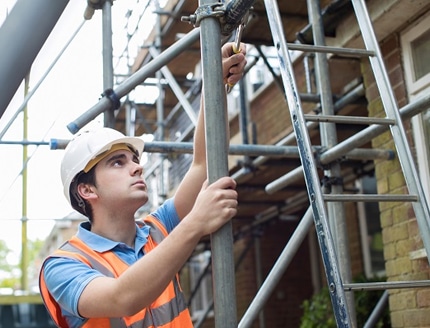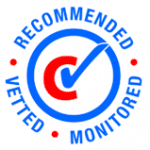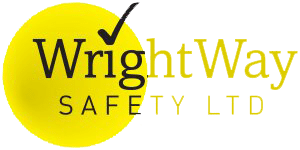Scaffolding Inspection
To ensure safety, it is necessary that you adhere to regular checks before and after scaffolding installation. We can conduct an initial scaffolding inspection and carry out checks on on-going projects. We have experienced people trained in advanced scaffold inspection. We provide a professional service and use only the high quality scafftag system. Our fully qualified inspectors can provide you with a site inspection before installation and after disassembling that complies with the latest health and safety regulations.
We understand that your scaffold won’t just be idle when it’s being built with Ace Scaffolding, which is why with a rigorous inspection and maintenance schedule, you can be assured that you’ll have access to your scaffold whenever you need it. You can rest assured your project is in safe hands. Ace Scaffolding has an excellent safety record, and an on-site Health & Safety Rep will be on your site while we work. We’re here to help, no matter your scaffolding needs. Need guidance? Speak to a professional We can also offer advice on scaffolding and access solutions tailored to your individual needs.
We Are Also Available to Offer Scaffolding Related Advice

The Basics of a Scaffolding Inspection
We provide independent scaffolding inspections and site scaffolding monitoring services adhering to the regulation 12(7) of the 2005 Work at Height Regulations. Being a legal obligation for scaffolding users, Ace Scaffolding provides support services on independent scaffolding inspections throughout Peacehaven. Users should confirm the safety features of the structure and make sure it is ready for operations. Our independent inspectors advise you professionally and impartially on scaffolding standards.
Why Do You Need to Conduct Scaffolding Inspections?
Scaffolding is an access form that’s used on most construction sites in various ways. Large framed scaffolding is prominent on sites that use it. For renovations, scaffolding could be a sign that the building project is starting from the outside. Working at heights has its share of risks. Statistics from 2017/18 recorded over 35 crashes from height incidents. HSE reports that falls from heights are responsible for 8% of non-fatal RIDDOR injuries. HSE tracks companies who do not maintain current safety standards with scaffolds.
When is the Best Time to Conduct Scaffold Inspections?
To comply with the 2005 Working at Heights Standard, scaffolding used for construction work must undergo inspection prior to first use and thereafter once every 7 days until it is taken down. Due to its extensive exposure to the elements, it is vital you confirm that your scaffolding is in safe and sound condition at all times. The scaffolding you use must be properly inspected, and it is your responsibility to ensure this has been done.
Who Should Inspect Scaffolding?
The Health, Safety, and Environment (HSE) management released guidance aimed at improving safety standards for the construction industry; stating that scaffold inspections “should be performed by a proficient person whose combination of training, experience and knowledge is adequate for the scaffold type and complexity”. The CISRS (Construction Industry Scaffolders Record Scheme) qualification represents competence for scaffold inspectors in the scaffolding industry.
It demonstrates competence, professionalism, and the importance of health and safety. However, someone who has received training in inspecting a specific type of scaffold system from an associated supplier or manufacturer can inspect the scaffold structure based on the experience and expertise. A person may be certified to inspect a basic scaffolding structure if they’ve been trained in scaffold inspection methods, and have successfully completed an inspector certification course.
Inspectors must record their observations after each inspection exercise and keep this report at hand throughout the project duration. After the project ends, the completed reports should be kept at a secure office location for the next three months. The scaffold inspection report should highlight any deficiencies or instances that could pose a threat to health and safety including any preventive/corrective action taken, even if said action is taken without delay. This makes recurring problems easy to identify. The following information should be included in each scaffolding report: Address and name of the person or organization for whom the inspection was carried out The inspector’s full name and his/her position. The date, time, and place.
A report on the worksite or the scaffolding inspection site. Details of any defects or objects discovered during the inspection that could endanger a person’s health or safety and how to remedy them. Additional information to ensure on-site safety. If you need guidance on scaffolding inspections, Ace Scaffolding Peacehaven are here to help. We perform independent scaffolding inspections, supervise scaffolding activities and conduct audits. We offer a range of scaffold inspection training for inspectors at various levels.
Our Guarantee
- Over Six Years Experience
- Unrivaled Experience
- An Exceptional Service
- Unbeatable Value For Money
- Industry-approved Scaffolders
- A Full Range of scaffolding Services
- Professional, Reliable and Diligent
- 100% Safety and Satisfaction
How Often Should Scaffolding be Inspected?
A work platform like a scaffold can only be used if it has been inspected within the last 7 days. The first inspection will take place as soon as the scaffolding has been erected. The result of the inspection is recorded as a handover certificate. Once it passes the inspection, you can put the scaffolding to use on your project. Regular inspections will then ensure that the scaffolding is safe for use.

This should be done on a weekly basis until the scaffolding is dismantled. It is risky to make use of scaffolding that hasn’t been inspected for over 7 days. If the scaffolding undergoes a change between inspections, you may need to examine it ahead of schedule. Additional inspections might be necessary in exceptional circumstances. This includes storms, as scaffolding can suffer substantial damage from high winds. This may be the case if, for example, a machine or vehicle were to affect the scaffolding.
It is recommended that a system similar to this one be developed for all work platforms that have the ability to drop a person above 2 metres. A thorough inspection of the scaffold system involves checking vital components such as the bracing, crash barriers, and the foundation. We will repair any errors in the structure, such as wobbly or sagging frames, and ensure signs of unauthorised alterations are fixed.
How Often Should a Harness be Inspected?
There are 3 recommended levels of inspection:
Pre-Use Testing
To ensure the integrity of the system, a safety inspection must be performed by the user before each shift. Defects should be reported to the employer.
Detailed Inspection
An officially recorded inspection should be performed at least every six months. The value should be reduced to a 3-month interval for equipment used more frequently in problematic field locations such as steel masts or towers, steel assembly, and scaffolding demolition areas.
Interim Inspection
These inspections are detailed and documented supplements to pre-use inspections and detailed inspections. Interim inspections could require a detailed check in a case where the employer’s risk assessment unearths a potential risk which could cause considerable deterioration and endanger the lanyard before the next scheduled detailed inspection.
The frequency of these inspections is dependent on usage. The more the asset is used the more frequently they should be analysed. Relevant examples include the dangers of working in high-risk environments using chemicals, sandblasting, or paint. There are some additives that have acid and alkaline risks, making it crucial to prevent these risks from occurring by performing periodic interim inspections.
Scaffolding Types

Who is Responsible for the Scaffold Inspection?
The 1999 Health and Safety Regulation makes it clear that employers must evaluate the risks to the safety and health of their employees and the general public who might be affected by the work. The 2015 Construction Regulation (Design and Administration) requires commercial customers to ensure that their projects are properly managed to ensure the health and safety of all who may be affected by the work, including the public. For domestic construction projects, the builder, contractor, or scaffolder is in charge of worksite safety.
Legal Requirements for Scaffold Inspection
- Scaffolding must be checked before use and confirmed in the initial test report or in a handover protocol. Scaffolding should be carefully examined on a weekly basis.
- It is necessary to check scaffolding on a regular basis, eliminating the risk of damage from alterations and adverse weather, to ensure that the structure is still safe and sound.
- Inspection reports are best kept in a format that can be transferred, with little effort, into printable form and protected against tampering.
- Before the end of the working period, the inspection report is prepared by the inspector and sent to the employer within 24 hours.
- The construction report must be kept at the job site until completion of construction and then filed in the employer’s office for 3 months afterwards.
We Are Also Available to Offer Scaffolding Related Advice
An Inspection Report Will Include the Following Information:
- The inspection report must indicate the name and address of the individual or organization for whom the inspection was done.
- The location of the inspection exercise. Details of the scaffold examination. The date and time the inspection exercise was completed.
- Information that has to do with threats to the safety of project stakeholders while on-site. Steps taken to resolve issues identified during the inspection exercise.
- Details about any move that is deemed important. The name and position of the individual who is in charge of the inspection report.
Recommendations By NASC
Here are some NASC recommendations
- If the employer proves that a CISRS card holder possesses adequate experience and expertise, they will be regarded as qualified to carry out scaffold inspections.
- If you are looking to get the contents of CISRS courses, check out CAP 609 General Information Booklet Appendix A-F pages 37-52. If an employer can prove that an individual has the right skills and experience to inspect a basic scaffold structure and such person has gone through the CISRS Basic Scaffold Inspection Training Scheme Course SITS, he or she would be considered qualified to inspect a basic scaffold structure.
- CISRS Advanced Scaffold Inspection Training Scheme offers certification for scaffolding inspectors. A person who has successfully completed this test is eligible to carry out inspection of a complex scaffold structure, if they can prove that they have the needed experience and expertise.
- This is a very essential course for experienced scaffold inspectors, supervisors, and managers who are in charge of handing over scaffolds, inspections, commissioning, and filling reports in compliance with Work at Height Regulations 2005.
- A CISRS SITS qualification is valid for a 5-year period. In an effort to ensure that all SITS delegates are qualified inspectors, each delegate will need to re-sit the SITS course after the validity period in order to maintain their CISRS qualification.
- The first step in scaffold inspection is familiarizing yourself with the system you will be inspecting. You should find out what kinds of scaffolds are in use and how to inspect them properly.
- One way to achieve this is through the supplier, manufacturer, or through training providers approved by CISRS.
We Are Also Available to Offer Scaffolding Related Advice
Our Emergency and Monitoring Scaffolding Inspections
We conduct both scheduled and emergency inspections on scaffolding systems. We include digital photographs and a written report in our deliverables.
Frequently asked questions
Should Scaffolds be inspected every day?
Can Scaffolding be Used in the Rain?
Are Scaffolding Tags Legally Required?
How Many Days does a scaffold tag stay valid after an inspection?
What is the Meaning of a Yellow Scaffold Tag?
Is a License Needed Before a Scaffold Gets Erected?
What Qualifications are needed for scaffolding?
How Long Should Scaffolding Record be on Site?
How Long before One Becomes a Qualified Scaffolder?
Is a Scaffold Handover Certificate Legally Required?
What is a Standard in Scaffolding?
When are Inspections needed on a Mobile Scaffolding Tower?
How frequently should equipment for working at Height be inspected?
Get in Touch With us for Your Scaffolding Hire Quotes












